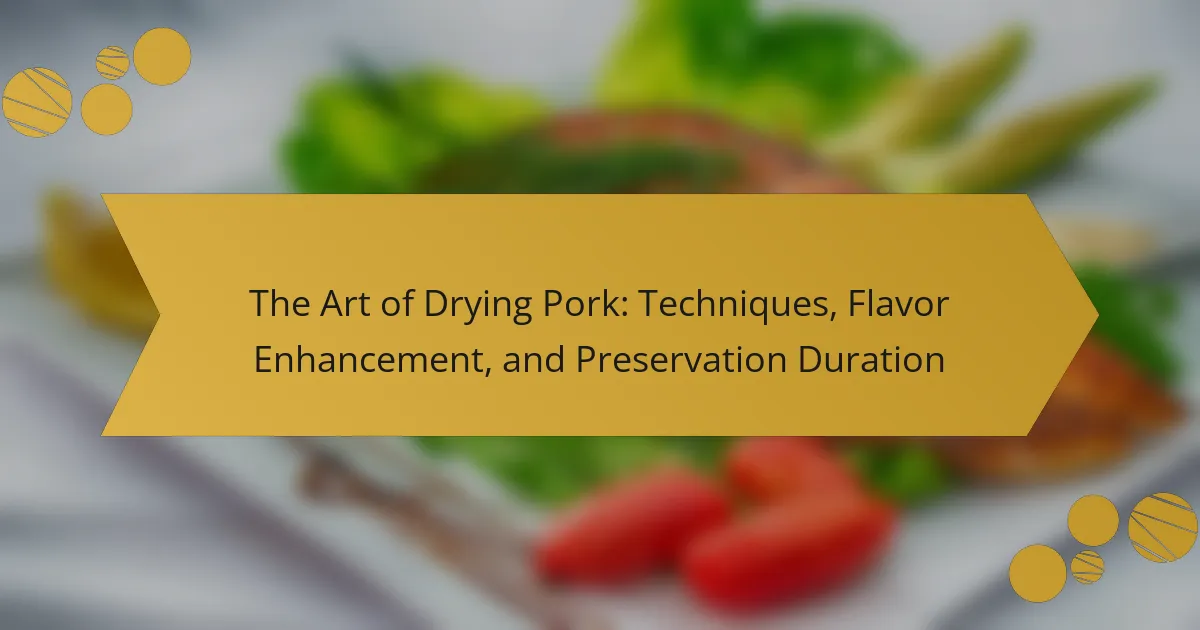
What is the art of drying pork?
The art of drying pork involves preserving the meat by removing moisture. This process enhances flavor and extends shelf life. Techniques include air drying, curing with salt, and using spices. Historically, drying pork dates back to ancient civilizations for food preservation. The moisture content in dried pork typically drops below 20%. This low moisture level inhibits bacterial growth, making it safe for consumption. Drying also concentrates the flavors, resulting in a rich taste. Various cultures have unique methods, contributing to diverse flavor profiles in dried pork products.
How does the drying process work in preserving pork?
The drying process preserves pork by reducing moisture content. This inhibits the growth of spoilage bacteria and molds. During drying, pork is typically salted first. Salting draws out moisture and enhances flavor. The meat is then exposed to air, heat, or smoke. These methods further remove moisture while adding unique flavors. Studies show that drying can extend the shelf life of pork significantly. For example, properly dried pork can last for months without refrigeration.
What are the essential steps involved in drying pork?
The essential steps involved in drying pork include selecting the meat, preparing it, seasoning, drying, and storing. First, choose high-quality pork cuts, such as loin or shoulder. Next, trim excess fat to prevent spoilage. Season the pork with salt and spices to enhance flavor and draw out moisture. Then, dry the pork using a dehydrator, air-drying, or smoking methods. Maintain a consistent temperature and humidity for optimal drying. Finally, store the dried pork in a cool, dark place or vacuum-seal it for longer shelf life. Properly dried pork can last for months without refrigeration.
How do temperature and humidity affect the drying process?
Temperature and humidity significantly influence the drying process. Higher temperatures generally speed up evaporation, allowing moisture to escape more quickly. However, excessive heat can lead to uneven drying and potential spoilage. Conversely, lower temperatures slow down the drying process, which can enhance flavor but may increase the risk of microbial growth if not monitored.
Humidity levels also play a critical role. Low humidity facilitates faster moisture removal, essential for effective drying. High humidity can hinder evaporation, prolonging drying time and potentially leading to undesirable texture and flavor changes. Studies show that optimal drying conditions typically require a balance of moderate temperature and low humidity to achieve the best results in preserving pork.
What techniques are commonly used for drying pork?
Common techniques for drying pork include air drying, smoking, and using a dehydrator. Air drying involves hanging the pork in a cool, dry place with good air circulation. Smoking adds flavor while reducing moisture through the heat of the smoke. Dehydrators use low heat and airflow to remove moisture efficiently. These methods have been used for centuries to preserve pork. Historical records show that air drying dates back to ancient civilizations. Smoking was popularized in various cultures for both preservation and flavor enhancement. Dehydrators became common in the 20th century, allowing for controlled drying conditions. Each technique results in unique flavors and textures in the final product.
What are the differences between air drying and smoking?
Air drying and smoking are two distinct methods of preserving pork. Air drying involves removing moisture from the meat using ambient air circulation. This method typically results in a concentrated flavor and a firmer texture. In contrast, smoking infuses the meat with flavors from wood smoke while also drying it. Smoking often adds a rich, smoky taste and can enhance preservation through the antimicrobial properties of smoke. Both methods extend the shelf life of pork, but they achieve this through different processes and flavor profiles.
How does using a dehydrator change the drying process?
Using a dehydrator accelerates the drying process by providing controlled heat and airflow. This method enhances moisture removal efficiency compared to traditional air drying. Dehydrators maintain a consistent temperature, typically between 120°F to 160°F. This range effectively inhibits bacterial growth while drying. The airflow in dehydrators promotes even moisture distribution, reducing drying time. Studies show that dehydrating can cut drying time by up to 50%. This efficiency preserves flavor and nutrients better than slower methods. Overall, a dehydrator streamlines the drying process for pork and other foods.
What are the flavor enhancement methods in drying pork?
Flavor enhancement methods in drying pork include marinating, seasoning, and brining. Marinating involves soaking pork in a mixture of acids, oils, and spices. This process infuses flavor and tenderizes the meat. Seasoning typically includes dry rubs made from herbs and spices. These enhance the natural flavors of the pork. Brining involves soaking pork in a saltwater solution. This method adds moisture and flavor during the drying process. Each method can significantly impact the final taste of the dried pork product. The combination of these techniques can create a unique flavor profile tailored to specific preferences.
How do marinades influence the flavor of dried pork?
Marinades enhance the flavor of dried pork by infusing it with various seasonings and acids. The process allows the pork to absorb flavors, making it more palatable. Ingredients like salt, herbs, and spices contribute to this flavor enhancement. Acids, such as vinegar or citrus juice, help tenderize the meat while adding tanginess. The marinating time affects the intensity of the flavors absorbed. Typically, longer marination leads to a more pronounced taste. Research indicates that marinating can significantly alter the flavor profile, improving overall enjoyment.
What spices and herbs are best for enhancing dried pork flavors?
Black pepper enhances dried pork flavors with its pungent kick. Paprika adds a smoky depth, enriching the overall taste. Garlic powder contributes a savory note that complements the meat’s richness. Onion powder provides sweetness and umami, balancing the flavor profile. Thyme introduces an earthy aroma, elevating the sensory experience. Rosemary offers a pine-like fragrance that pairs well with pork. Cumin adds warmth and a slightly nutty flavor, making it unique. These spices and herbs are commonly used in various dried pork recipes, proving their effectiveness in flavor enhancement.

What are the benefits of drying pork?
Drying pork offers several benefits. It enhances preservation by reducing moisture content, which inhibits bacterial growth. This method extends the shelf life of pork significantly. Dried pork retains concentrated flavors, making it more flavorful than fresh pork. Nutritional value remains intact, providing essential proteins and minerals. Additionally, drying allows for convenient storage and transport. Historically, cultures have utilized drying as a means of food preservation for centuries. For example, jerky is a popular dried pork product that showcases these benefits.
Why is dried pork a popular choice for preservation?
Dried pork is a popular choice for preservation because it effectively reduces moisture content, inhibiting bacterial growth. The drying process extends the shelf life of pork significantly. Historically, methods like air drying and smoking have been used for centuries to preserve meats. Dried pork can last for months or even years without refrigeration. Additionally, it retains flavor and nutritional value during the drying process. The high protein content in pork also contributes to its appeal as a preserved food option. Various cultures have embraced dried pork for its convenience and taste.
How does drying pork compare to other preservation methods?
Drying pork is a preservation method that removes moisture, inhibiting microbial growth. Compared to refrigeration, which slows spoilage by maintaining low temperatures, drying extends shelf life significantly. Dried pork can last months without refrigeration, while refrigerated pork typically lasts only a week.
In contrast, curing involves adding salt or sugar to inhibit bacteria, which can also extend shelf life. However, curing may alter the flavor and texture differently than drying. Another method is smoking, which adds flavor while also drying the meat. Smoking can provide a unique taste but may not extend shelf life as effectively as drying alone.
Research shows that drying can reduce weight by about 50%, concentrating flavors and nutrients. A study in the Journal of Food Science indicated that dried meats retain more protein and minerals compared to fresh or refrigerated counterparts. Thus, drying pork not only preserves it but also enhances its flavor and nutritional profile.
What nutritional benefits does dried pork offer?
Dried pork offers high protein content, essential for muscle repair and growth. It typically contains around 30 grams of protein per 100 grams. This meat also provides significant amounts of vitamins, particularly B vitamins like B12 and niacin. These vitamins support energy metabolism and red blood cell formation. Dried pork is rich in minerals such as iron and zinc. Iron is crucial for oxygen transport in the body, while zinc supports immune function. Additionally, it has a low carbohydrate content, making it suitable for low-carb diets. The drying process can concentrate flavors and nutrients, enhancing its overall nutritional profile.
How does drying pork impact its shelf life?
Drying pork significantly extends its shelf life. The removal of moisture inhibits the growth of spoilage bacteria and mold. This process can increase shelf life from a few days to several months or even years, depending on storage conditions. For example, properly dried and stored pork can last up to 12 months without refrigeration. Research shows that moisture content below 15% is ideal for preservation. This low moisture level creates an environment unsuitable for microbial growth. Additionally, drying concentrates flavors, enhancing the overall taste of the pork. The combination of reduced moisture and enhanced flavor makes dried pork a popular preservation method.
What factors influence the preservation duration of dried pork?
The preservation duration of dried pork is influenced by several key factors. These factors include moisture content, storage conditions, and packaging methods. Lower moisture content in dried pork extends its shelf life. Ideal storage conditions involve cool, dark, and dry environments. High temperatures or humidity can accelerate spoilage. Additionally, vacuum sealing or using airtight containers helps prevent oxidation and contamination. Studies show that properly dried and stored pork can last for months to years. For instance, dried pork stored at room temperature can last up to 6 months, while refrigeration can extend this duration significantly.
How can proper storage extend the shelf life of dried pork?
Proper storage can significantly extend the shelf life of dried pork. Storing dried pork in a cool, dark place prevents moisture absorption. Moisture can lead to spoilage and mold growth. Using airtight containers also protects against air exposure. Air can cause oxidation, which deteriorates flavor and quality. Additionally, refrigeration can further prolong shelf life. Studies show that dried meats stored at lower temperatures last longer. Vacuum sealing is another effective method for extending shelf life. Vacuum sealing removes air, minimizing spoilage risks. Proper storage techniques can double or even triple the shelf life of dried pork.

What challenges are associated with drying pork?
Drying pork presents several challenges. One major challenge is maintaining proper temperature control during the drying process. If the temperature is too high, it can lead to uneven drying or spoilage. Conversely, if the temperature is too low, it may result in insufficient moisture removal, which can promote bacterial growth.
Another challenge is achieving the right humidity levels. High humidity can slow down the drying process and increase the risk of mold formation. Low humidity can cause the pork to dry too quickly, leading to a tough texture.
Additionally, selecting the appropriate cut of pork is crucial. Different cuts have varying fat content, which affects drying time and flavor. Fat can also go rancid if not properly managed during drying.
Lastly, ensuring food safety is a significant challenge. Proper sanitation and handling practices must be followed to avoid contamination. According to the USDA, the safe drying temperature should reach at least 160°F to eliminate harmful bacteria.
What common mistakes should be avoided in the drying process?
Common mistakes to avoid in the drying process include inadequate temperature control. Maintaining a consistent temperature is crucial for effective drying. Fluctuations can lead to uneven moisture removal and spoilage. Another mistake is not properly preparing the meat. Trimming excess fat helps reduce rancidity during drying. Additionally, overcrowding the drying space can impede air circulation. Proper airflow is essential for even drying results. Failing to monitor humidity levels can also lead to issues. High humidity can slow down the drying process and promote bacterial growth. Lastly, neglecting sanitation can introduce contaminants. Clean equipment and surfaces are vital for safe drying.
How can improper drying lead to spoilage?
Improper drying can lead to spoilage by allowing moisture to remain in the pork. High moisture content creates an environment conducive to bacterial growth. Bacteria can multiply rapidly at temperatures above 40°F. This can result in foodborne illnesses if consumed. Additionally, insufficient drying may cause mold to develop on the surface. Mold can produce mycotoxins, which are harmful to health. The USDA states that proper drying reduces the risk of spoilage and extends shelf life. Therefore, effective drying techniques are essential for safe pork preservation.
What are the signs of poorly dried pork?
Signs of poorly dried pork include a sticky or tacky surface. This indicates that moisture is still present. Additionally, poorly dried pork may have an off or sour smell. This odor suggests spoilage or fermentation. The texture may also be overly soft or mushy, lacking the desired firmness. Furthermore, the color can appear dull or uneven, rather than a consistent hue. Lastly, if mold is present, it signifies inadequate drying conditions. These signs collectively indicate that the pork has not been properly dried and may be unsafe to consume.
What are the best practices for drying pork at home?
The best practices for drying pork at home include selecting high-quality cuts and ensuring proper sanitation. Use fresh pork with minimal fat for optimal drying results. Trim excess fat to prevent spoilage. Marinate the pork in a salt-based brine to enhance flavor and safety. Maintain a consistent temperature between 60°F to 70°F during the drying process. Utilize a dehydrator or an oven set to low heat for effective drying. Ensure good air circulation around the pork to facilitate moisture removal. Monitor the drying process until the pork reaches a firm texture and a moisture content below 20%. These practices help ensure the safety and quality of the dried pork.
How can one ensure consistent results when drying pork?
To ensure consistent results when drying pork, maintain controlled temperature and humidity levels. Ideal drying conditions typically range from 60°F to 80°F with humidity below 60%. Use a reliable dehydrator or controlled air circulation for even drying. Regularly check the pork for moisture content during the process. Properly slice the pork to uniform thickness for consistent drying. Marinating the pork can enhance flavor without affecting drying consistency. Following these practices leads to better texture and flavor retention. Research indicates that maintaining these parameters can reduce spoilage and improve product quality.
What tools and equipment are recommended for successful drying?
Dehydrators are essential tools for successful drying. They provide controlled heat and airflow, ensuring even drying. Food dehydrators can reduce moisture content efficiently. Additionally, an oven can be used for drying if set to a low temperature. A fan can enhance airflow, speeding up the drying process. A meat thermometer ensures the pork reaches safe temperatures during drying. Vacuum sealers help store dried pork, preventing moisture re-entry. Finally, drying racks provide a surface for air circulation, improving drying efficiency.
What tips can enhance the drying experience for beginners?
To enhance the drying experience for beginners, maintain a consistent temperature between 60°F and 80°F. This range prevents spoilage while promoting proper drying. Use a fan to improve air circulation, which helps remove moisture effectively. Ensure meat is cut into uniform pieces for even drying. Salt the pork beforehand to draw out moisture and enhance flavor. Monitor humidity levels; ideal conditions are below 60% humidity. Check the meat regularly to avoid over-drying. Use a food thermometer to ensure the internal temperature reaches 145°F for safety. These practices lead to better texture and flavor in dried pork.
How can beginners experiment with flavors when drying pork?
Beginners can experiment with flavors when drying pork by using various marinades and seasonings. They can start with simple salt and pepper for basic flavor. Adding garlic powder, onion powder, or smoked paprika can enhance the taste. Beginners can also try sweeteners like brown sugar or honey for a sweet glaze. Using soy sauce or Worcestershire sauce can introduce umami flavors. Additionally, they can explore herbs such as thyme, rosemary, or oregano for aromatic notes. Experimenting with different combinations helps find unique flavor profiles. Testing small batches allows for adjustments without wasting ingredients.
What resources are available for learning more about drying pork?
Books on drying pork include “Charcuterie: The Craft of Salting, Smoking, and Curing” by Michael Ruhlman. This book provides detailed techniques for drying meats, including pork. Online resources include websites such as the National Center for Home Food Preservation. They offer guidelines on safe drying practices. YouTube channels dedicated to food preservation also provide visual tutorials. Forums like the Smoking Meat Forums allow for community discussions and shared experiences. Cooking classes focused on charcuterie can provide hands-on learning opportunities.
The main entity of this article is the art of drying pork, which encompasses various techniques for preserving meat by removing moisture to enhance flavor and extend shelf life. Key techniques discussed include air drying, smoking, and using dehydrators, each contributing unique flavor profiles and textures. The article also outlines essential steps in the drying process, the impact of temperature and humidity on preservation, and methods for flavor enhancement through marinades and seasonings. Additionally, it highlights the nutritional benefits and challenges associated with drying pork, providing best practices for achieving consistent results at home.
